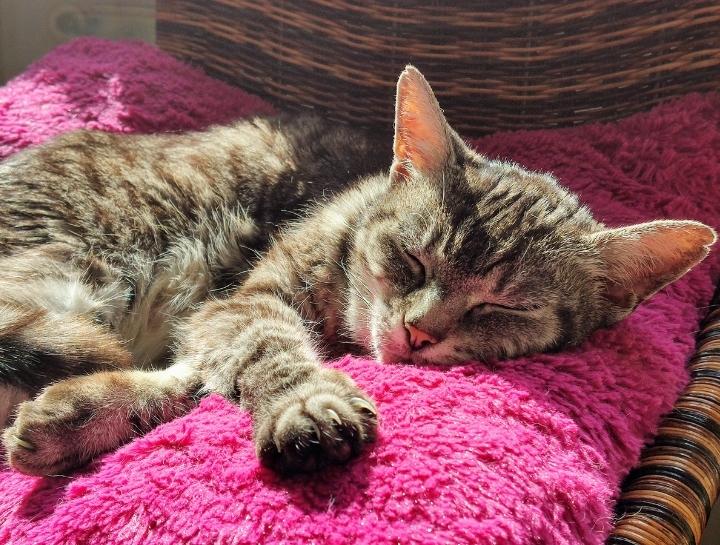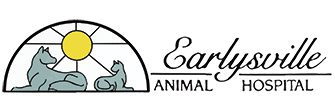New Help for Painful Kitties & Helping Your Cat be Happy at the Animal Hospital

New Help for Painful Kitties
Did you know 40% of all cats have painful osteoarthritis and that by the time cats are 12 years of age, 90% suffer from this disease?
Since cats are masters at hiding disease they don’t give the same clues a dog would, like limping or having difficulty rising from lying down.
Instead, we pet owners need to be keen observers to figure out they are in pain. Some of the signs to watch for include:
- Overgrown toenails
- Decreased grooming
- Excess licking in one spot over a joint, on the belly or sides
- Moving slowly on the stairs
- Struggling to jump up or down
- Decreased playing
Thankfully, there is a checklist to help you know when your cat is in pain from osteoarthritis: Feline Osteoarthritis Checklist | Zoetis Petcare
We are so happy to have a new treatment to help these cats in a once-a-month injectable medication that blocks Nerve Growth Factor (NGF). It takes a full 60 days to see maximum effects that are often life-changing, but many cats feel dramatically better even 30 days after the first injection.
We want to help! Please set up an appointment and we will see if this is a good option for your kitty.
It is very helpful if you can take short videos of your cat walking, jumping up and down, playing, and negotiating stairs. Be sure to take these in a well-lit area. Bring the videos with you to share with your kitty’s veterinarian.
Helping your cat be happy at the animal hospital
The International and American Associations for Cat Veterinarians (AAFP and ISFM) have written new guidelines for how we handle cats at the animal hospital to improve their welfare and decrease fear, anxiety, and pain during veterinary visits.
These new guidelines come from 10 years of feline behavior research across the world as well as 10 years of experience in Cat-Friendly Practices, like Earlysville Animal Hospital.
We are excited to learn new techniques that will help us take care of our precious patients.
Research has proven that what we recommend is true. The best veterinary visit starts at home.
Please train your cat to feel comfortable in their cat carrier long before the visit. The door should be removed so your cat can enter the carrier anytime. The carrier should be placed in the part of the house your cat loves the most where they play, sleep, eat and drink. Train the cat to love it by making it super comfortable and placing things the cat loves in it including favored toys and tasty treats. Taking the lid off as well as the door helps some cats explore the carrier.
The newest research tells us the safest place for the carrier in your car is on the floor of the back seat. Drive carefully and play soothing music during the drive. Cover the carrier with a Pheromone sprayed towel to let your cat hide in his safe space during the drive.
When carrying your cat in his carrier, remember he is precious cargo, not a suitcase. Hold the carrier securely so it doesn’t swing so he stays as comfortable as possible.
Have we recommended premedication for your cat to take prior to his visits? This is to make the visit more comfortable for him and to lower his stress, fear, and pain during the visit. He may eat the medication if you open the capsule and sprinkle it on the smelliest and tastiest treat. Give pre-meds 3 hours prior to trying to get him in the carrier.
Remember, chasing your cat is stressful for you and your cat! Instead, lure him into a space where you can easily get him in the carrier. If he doesn’t think the carrier is a welcome space, try taking the carrier and your cat into a small room like a bathroom where he doesn’t have a place to hide. Wrapping him in a pheromone-sprayed towel makes picking him up and placing him in the carrier easier if you can’t lure him into the carrier with treats.
Call us if you need premedications or help to make the carrier and car ride enjoyable for your cat.
Getting Your Cat to the Veterinarian from Cat Friendly Homes >>
OK, getting your cat to the veterinarian and the visit itself have gone well because you prepared well at home and we used the best handling techniques at Earlysville Animal Hospital. There is still one more step - getting back home.
Coming Home and Keeping the Peace in a Multi-Cat Household
Cats are very sensitive to smells, and unfamiliar smells can result in one cat no longer recognizing another. When your cat returns home from the veterinarian’s office, she will smell different and unfamiliar. Aggressive behavior can occur when one cat senses another as a stranger. These suggestions can help avoid problems between cats following a veterinary visit:
- Leave your returning cat in the carrier for a few minutes to see how all of your other cats react.
- If there is hissing, keep the returning cat in a separate room with all they need to be comfortable (food, water, litter box, and comfy bed), especially if your cat had an operation and could still feel the anesthetic medication for 24 hours.
- The returning cat will begin to smell familiar again through grooming and contact with the home environment. Swap bedding that has each cat’s scent on it to help to re-establish your cat’s normal smells.
- After a few hours, or possibly longer following an operation, and based on your veterinarian’s advice, slowly allow contact with the other cats.
- Watch what your cats do when they see each other. If they seem angry or run away from each other they may need more time separated before trying again.
- Using special feline pheromone plug-ins and sprays where your cats spend most of their time can help.
- Remember that your cat may be wobbly when they get home if they had premedication. Keep them indoors for at least 8 hours and protect them from injury by blocking them off from stairs and high places.
